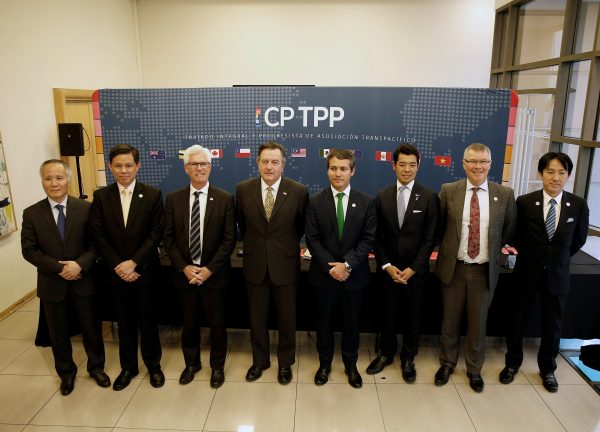Australia and other members can help lock China into new rules and reforms that entrench the market and constrain behaviour. China’s trade coercion against Australia should be resolved as part of the accession process, not used to stymie the strategic opportunity.
The United States led the negotiations of the Trans-Pacific Partnership (TPP) agreement before President Trump nixed the deal on day one of his presidency. The deal created new rules for international commerce where they were lacking in the WTO and opened new markets for its members. Strategically, it was meant to entrench the United States in Asia and counter China’s economic influence. Now Beijing has made formal its interest in joining while the Biden administration is hamstrung by domestic opposition.
Australia together with Japan, the largest economy in the pact, revived the TPP deal as the Comprehensive and Progressive Agreement for Trans-Pacific Partnership (CPTPP) in 2018 that keeps the door open for the United States. The United Kingdom is another potential new entrant to the CPTPP.
Beijing likely has two objectives from membership. Strategically, it can opportunistically wedge some of the membership, especially US allies, and take advantage of US absence. Economically China can use the CPTPP as external pressure to push reforms. To some that may sound like an anathema to China under President Xi Jinping where the market appears in retreat and the state in ascendency. The reality is that Chinese prosperity and dynamism already comes from the private sector which accounts for 60 per cent of GDP, 70 per cent of innovation, 80 per cent of urban employment and 90 per cent of exports.
Chinese membership of CPTPP would mean disciplines on state-owned enterprises, the introduction of new labour rights, higher environmental standards, free flow of data and opening up government procurement to foreign competition. Those are high hurdles for membership but are consistent with China’s Common Prosperity economic reform agenda.
Developing country members of CPTPP like Vietnam and Malaysia managed to negotiate exemptions from some commitments but China would not expect any such carve outs. Australia helped water down egregious intellectual property rights protections from the United States that China should be able to sign onto now as a major innovator in its own right.
The industrial subsidies that Chinese state-owned enterprises enjoy distort markets and competition in China. China’s weight in the global economy means those distortions spill over into international markets. State-owned enterprises are a recognised drag on growth and represent powerful vested interests. The Chinese government is aware that CPTPP membership would require significant reform — the state-owned enterprise chapter of the TPP was written precisely with China in mind.
Reformers in China have used external leverage to push reform in the past. This December marks 20 years since China joined the WTO. That was a watershed moment in Chinese opening up and reform, and for the global trading system. It took 15 years for China to join the WTO as it delivered on market opening and negotiated commitments to rules beyond other members as the price for entry. Its rise to becoming the world’s largest trading nation and second largest economy is significantly a consequence of implementing those commitments. Its record of compliance is as good as any other large economy even as it learnt to navigate the system. Many of the problems with China in the WTO stem from the rules being out of date, not mainly compliance issues.
A more powerful and assertive China still needs to align external leverage for its domestic reforms. Its membership of East Asia’s Regional Comprehensive Economic Partnership agreement with Australia, Japan, New Zealand, South Korea and all of Southeast Asia locked China into new rules and discipline. But some higher standard rules in the CPTPP are needed to push deeper reforms in China.
Chinese interest in the CPTPP may help entice the United States back into the pact. The Biden administration has responded with a willingness to consider the ‘opportunity’ to negotiate entry into the CPTPP but will require changes. The existing membership expended significant political capital in making concessions to the United States and changes to the deal will not come easily or quickly. On China’s entry, the Biden administration has deferred the decision to CPTPP members while pointing out that China’s non-market practices will make that difficult.
With Beijing having unleashed economic coercion on Australia the temptation may be to block Chinese entry. That would be the wrong strategy. Having sent a clear message to China and the region of a hardened security posture with the new Australia–United Kingdom–United States security pact announced last week, Australia now needs to send a clear signal on its strategic economic interests in Asia. The Chinese economy and its trajectory are too important to Australia and all of Australia’s economic partners in Asia to disregard. Canberra should use this rare strategic opportunity to work with China and enmesh a rising China in new rules, disciplines and the international market.
Shiro Armstrong is Director of the East Asian Bureau of Economic Research and Editor of the East Asia Forum at the Crawford School of Public Policy, ANU. This piece was originally published in the Australian Financial Review.


It would be prudent to let China join. Thinking the BRI is spinning the wheels and this might be a good way to engage with China
This argument holds if today’s China really had reformers – those who prioritize unleashing forces of the market over state control. China did seem to have such reformers under Jiang Zemin and Hu Jintao. Thus engagement policy made sense. Those were indeed good days. How about today? Canberra would really need to present solid evidence that such reformers still exist and are influential in Beijing, if it wanted to persuade stakeholders to even sit down and contemplate ‘engaging Xi Jinping’s China’ scheme.